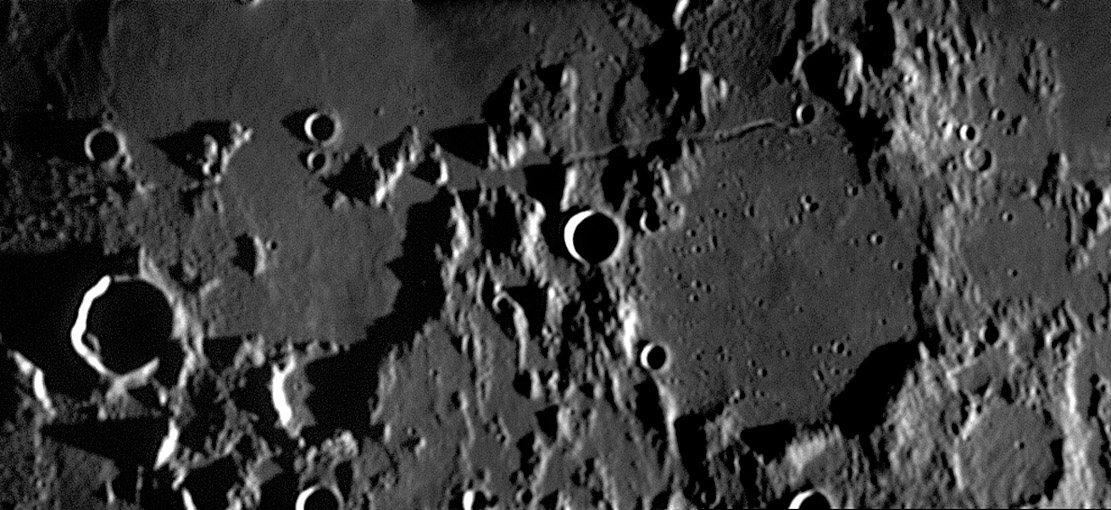March 8, 2008
Not Flying

image by Jim Phillips
The floor of Ptolemaeus is famous for its shallow saucers visible only with very low illumination. Albategnius is a much less known second example, and Jim's low Sun imaging has revealed a third nearby instance. In this case the crater is Flammarion, which in some ways is a half size version of Ptolemaeus. Its 75 km diameter is only half that of Ptolemeaus, and its angular outline, battered walls and flat-ish floor are good matches. The 13 km wide fresh crater Mösting A on the western wall of Flammarion provides a scale for the saucers within. The most conspicuous near the center of the floor is about 10 km in diameter, others are less distinct and smaller. All these saucers started out as impact craters pockmarking the floors of larger craters. The formation of the Imbrium basin broadcast ejecta over vast distances, and Ptolemaeus, Albategnius and Flammarion were close enough that their interiors were deeply filled with material that must have flowed almost like a liquid. Central peaks, terraces and random impacts that were on their floors were covered, and as the ejecta mass cooled it probably degassed and compacted, draping over the rims of buried craters, leaving ghostly reminders. These three large craters with saucered floors are clustered together - are there more saucers in other parts of Imbrium's ejecta? And were any saucers created by ejecta from Orientale?
Chuck Wood
Technical Details
Feb 16, 2008. TMB 8" F/9
Related Links
Rükl plate 44
Flammarion times two
Yesterday's LPOD: The End of the Future
Tomorrow's LPOD: A Hill in the Middle
COMMENTS
(1) There is a problem of some kind with the Wiki website. Since yesterday, every time I click on the "LPOD Index" it produces an error message that closes my browser and knocks me offline. (??) My browser is AT&T Yahoo. It works fine on all other sites.
--Bill
(2) Bill - I don't have that problem and the code looks OK. But maybe Jim Mosher or someone else can check to see if something inadvertently changed when I entered the March 7 LPOD Index link.
Chuck
(3) Thanks, Chuck. Hope your conference goes well. With all the exploration going on, this must be busy and exciting times for lunar & planetary science professionals.
By the way, I found an article on the origin of the Moon written by a professor at the University of Hawaii that answered my questions about volatile elements, etc. As an amateur, I'm enjoying becoming a student again and learning these things. Since I'm mostly retired now, I fortunately have the time available.
--Bill
(4) The Ptolemaeus-like lumpiness on the floor of Flammarion (including the central dimple) is confirmed by the slightly lower Sun view of Consolidated Lunar Atlas Plate E12. I don't know about the Orientale area, but not straying too far from here, the floor of Hipparchus seems to me to have a similarly dimpled appearance at low Sun, as can be seen by comparing CLA plates E10 and E13. Ranger IX photo B001 confirms the bowl-like shape of the largest of the dimples: the interior of the flooded 28-km diameter crater on the western floor of Hipparchus, which in many ways seems like a larger echo of Ptolemaeus B (the prominent "saucer" in the north part of Ptolemaeus).
-  JimMosher
JimMosher
COMMENTS?
Register, Log in, and join in the comments.



